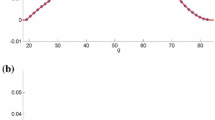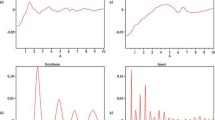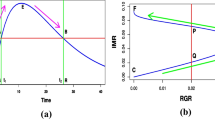Abstract
In this paper, we discuss a few empirical estimates of relative growth rate and their distributions based on two well-established parametric structures of the size variable- normal and log-normal with different growth curve models as the mean process. We discuss some exact and asymptotic testing procedures applicable to test the equality of expected relative growth rates over two or more different environmental situations, e.g. distinct geographical locations, several biological species, etc. Along with the tests under the parametric structures for the size variable, we consider some nonparametric tests as well. We perform tests for two other important hypotheses—whether the times taken to reach the maximum values of the relative growth rates are equal for all environments and whether those maximum values are equal. We illustrate our methods with two real life examples. The performances of the various testing procedures are studied by means of their power functions. Our methods have immense practical value in growth rate modeling in the biological context.






Similar content being viewed by others
References
Aikio, S., Ruotsalainen, A.L.: The modelled growth of mycorrhizal and non-mycorrhizal plants under constant versus variable soil nutrient concentration. Mycorrhiza 12, 257–261 (2002)
Banik, P., Pramanik, P., Sarkar, R., Bhattacharya, S., Chattopadhyay, J.: A mathematical model on the effect of M.denticulata weed on different winter crops. Biosystems 90, 818–829 (2007)
Bhattacharya, S.: Growth curve modelling and optimality search incorporating chronobiological and directional issues for an Indian major carp Cirrhinus Mrigala, Ph.d. dissertation, Jadavpur University, Kolkata, India (2003)
Bhattacharya, S., Basu, A., Bandyopadhyay, S.: Goodness-of-fit testing for exponential polynomial growth curves. Commun. Stat. Theory Methods 38(3), 340–363 (2008)
Bhattacharya, S., Basu, A., Bandyopadhyay, S.: Goodness-of-fit testing for exponential polynomial growth curves. Commun. Stat. Theory Methods 38(3), (2009)
Bhattacharya, S., Gupta, A., Chattopadhyay, A.K.: Effect of migration on population growth under dynamical system. J. Appl. Probab. Stat. 4(2), 239–253 (2009)
Bhowmick, A., Bhattacharya, S.: A new growth curve model for biological growth: some inferential studies on the growth of Cirrhinus mrigala. Math. Biosci. 254, 28–41 (2014)
Bhowmick, A., Chattopadhay, G., Bhattacharya, S.: Simultaneous identification of growth law and estimation of its rate parameter for biological growth data: a new approach. J. Biol. Phys. 40, 71–95 (2014)
Bhowmick, A.R., Saha, B., Ray, S., Chattopadhyay, J., Bhattacharya, S.: Cooperation in species: interplay of population regulation andextinction through global population dynamics database. Ecol. Model. 312, 150–165 (2015)
Booker, F., Muntifering, R., McGrath, M., Burkey, K., Decoteau, D., Fiscus, E., Manning, W., Krupa, S., Chappelka, A., Grantz, D.: The ozone component of global change: Potential effects on agricultural and horticultural plant yield, product quality and interactions with invasive species. J. Integr. Plant Biol. 51, 337–351 (2009)
Brewster, J.L., Barnes, A.: A comparison of relative growth rates of sifferent individual plants and different cultivars of onion of diverse geographic origin at two temperatures and two light intensities. J. Appl. Ecol. 18(2), 589–604 (1981)
Chakraborty, B., Bhattacharya, S., Basu, A., Bandyopadhyay, S., Bhattacharjee, A.: Goodness-of-fit testing for the gompertz growth curve model. Metron 72(1), 45–64 (2014)
Chakraborty, B., Bhattacharya, S., Basu, A., Bandyopadhyay, S., Bhattacharjee, A.: Goodness-of-fit testing for the Gompertz growth curve model. Metron 72(1), 45–64 (2014)
Diggle, P.J., Liang, K.Y., Zeger, S.L.: Analysis of Longitudinal Data. Clarendon Press, Oxford (1994)
Fieller, B.A.: The distribution of the index in a normal bivariate population. Biometrika 24, 428–440 (1932)
Fisher, R.: Some remarks on the methods formulated in a recent article on ’The quantitative analysis of plant growth. Ann. Appl. Biol. 7, 367–372 (1921)
Fishman, J., Creilson, J., Parker, P., Ainsworth, E., Vining, G., Szarka, J., Booker, F., Xu, X.: An investigation of widespread ozone damage to the soybean crop in the upper Midwest determined from ground-based and satellite measurements. Atmos. Environ. 44, 2248–2256 (2010)
Florio, M., Colautti, S.: A logistic growth theory of public expenditures: a study of five countries over 100 years. Public Choice 122, 355–393 (2005)
Gupta, A., Bhattacharya, S., Chattopadhyay, A.K.: Exploring new models for population prediction in detecting demographic phase change for sparse census data. Commun. Stat. Theory Methods 41, 1171–1193 (2012)
Heagle, A.: Ozone and crop yield. Annu. Rev. Phytopathol. 27, 397–423 (1989)
Heck, W., Heagle, A., Shriner, D.: Air pollution, vol. VI of supplement to air pollutants, their transformation, transport and effects, 3rd edn. Academic Press, New York ( 1986)
Hill, W.R., Ryon, M.G., Schilling, E.M.: Light limitation in a stream ecosystem: responses by primary producers and consumers. Ecology 76(4), 1297–1309 (1995)
Hinckley, D.: On the ratio of two correlated normal random variables. Biometrika 56(3), 635–639 (1969)
Hoffmann, W.A., Poorter, H.: Avoiding bias in calculations of relative growth rate. Ann. Bot. 90(1), 37–42 (2002)
Hutchings, M.J., de Kroon, H.: Foraging in plants: the role of morphological plasticity in resource acquisition. Adv Ecol Res 25, 159–238 (1994)
Koopmans, T.: Serial correlation and quadratic forms in normal variables. Ann. Math. Stat. 13, 14–33 (1942)
Marsaglia, G.: Ratios of normal variables and ratios of sums of uniform variables. J. Am. Stat. Assoc. 60, 193–204 (1969)
Merrill, A.: Frequency distribution of an index when both the components follow the normal law. Biometrika 20A(1/2), 53–63 (1928)
Moogouei, R., Karbassi, A.R., Monavari, S.M., Rabani, M., Taheri, M.A.: Effect of the selected physico-chemical parameters on growth of rainbow trout (Oncorhynchus mykiss) in raceway system in Iran. Iran. J. Fish. Sci. 9(2), 245–254 (2010)
Mosimann, J.E.: Size allometry: size and shape variables with characterizations of the lognormal and generalized gamma distributions. J. Am. Stat. Assoc. 65(330), (1970)
Mosimann, J.E., James, F.C.: New statistical methods for allometry with application to Florida red-winged blackbirds. Evolution 33(1), 444–459 ( 1979)
Oja, H., Randles, R.: Multivariate nonparametric tests. Stat. Sci. 19, 598–605 (2004)
Paine, C.E., Toby, R.M., Deborah, R.V., Purves, D., Rees, M., Hector, A., Turnbull, L.A.: How to fit nonlinear plant growth models and calculate growth rates: an update for ecologists. Meth Ecol Evol 3(2), 245–256 (2012)
Pan, Z., Lin, D.Y. : Goodness-of-fit methods for generalized linear mixed models. Biometrics, 61 (2005)
Pham-Gia, T., Turkkan, N., Marchand, E.: Density of the ratio of two normal random variables and applications. Commun. Stat. Theory Methods 35, 1569–1591 (2006)
Potthoff, R.F., Roy, S.N.: A generalized multivariate analysis of variance model useful especially for growth curve problems. Biometrika 51(3/4), 313–326 (1964)
Rao, C.R.: Advanced Statistical Methods in Biometric Research. Wiley, New York (1952)
Ryel, R., Caldwell, M., Manwaring, J.: Temporal dynamics of soil spatial heterogeneity in sagebush–wheatgrass steppe during a growing season. Plant Soil 184, 299309 (1996)
Sandland, R.L., McGilchrist, C.A.: Stochastic growth curve analysis. Biometrics 35, 255–271 (1979)
Seber, G.A.F., Wild, C.J.: Nonlinear Regression. Wiley, New York (2003)
Siangas, L., Pouilly, M., Vallejos, A., Perez, T., Rejas, D.: Effect of water quality on growth of four fish species in the Itenez basin (Upper Madera, Amazon). Environ. Biol. Fishes 95, 371–381 (2012)
Sibley, R.M., Barker, D., Denham, M.C., Hone, J., Pagel, M.: On the regulation of populations of mammals, birds, fish, and insects. Science 309, 607–610 (2005)
Smith, D., Piedrahita, R.: The relation between phytoplankton and dissolved oxygen in fish ponds. Aquaculture 68, 249–265 (1988)
Venables, W.N., Ripley, B.D.: Modern Applied Statistics with S, 4th edn. Springer, New York (2002). ISBN 0-387-95457-0
Viadero, R.C.: Factors affecting fish growth and production. Water Encycl. 3, 129–133 (2005)
Vonesh, E. S., Chinchilli, V. M., Pu, K.: Goodness-of-fit in generalized nonlinear mixed effects models. Biometrics 52, 572–587 (1996)
William, Y., Trent, R.: Geometric mean approximations of individual security and portfolio performance. J. Financial Quant. Anal. 4, 179–199 (1969)
Acknowledgments
The authors are extremely thankful to an editor, an associate editor and the reviewers for their suggestions which have helped a lot to improve the paper.
Author information
Authors and Affiliations
Corresponding author
Appendix
Appendix
1.1 Proof of Theorem 2.1
The RGR estimate for the i-th individual from the j-th population at time t, i.e. \(R_{ji}(t)\) can be written as
Here we are retaining up to the 2nd order terms. Rao [37], Chakraborty et al. [13], Bhattacharya et al. [4] have made sincere efforts for establishing the convergence of the series with higher order terms. We have provided the justification for the above approximation in our main article.
Now, the approximate expression for the mean of \(R_{ji}(t)\), i.e. \(\mu ^*_j(t)\) in Eq. 3, follows from the expectation terms– \(E[X_{ji}(t+1)] = \mu _j(t+1)\), \(E[X_{ji}(t)] = \mu _j(t)\), \(E[{(X_{ji}(t+1)-\mu _j(t+1))}^2] = \sigma _j(t+1, t+1)\) and \(E[{(X_{ji}(t)-\mu _j(t))}^2] = \sigma _j(t, t)\) with the notations \(V_{j,t+1} = \frac{\sqrt{\sigma _j(t+1,t+1)}}{\mu _j(t+1)}\), \(V_{j,t} = \frac{\sqrt{\sigma _j(t,t)}}{\mu _j(t)}\).
The approximate expression for the variance of \(R_{ji}(t)\), i.e. \(\sigma ^*_j(t,t)\) in Eq. 4, follows from the variance and covariance terms– \(Var(X_{ji}(t+1)-\mu _j(t+1))=\sigma _j(t+1,t+1)\), \(Var(X_{ji}(t)-\mu _j(t))=\sigma _j(t,t)\), \(Var({(X_{ji}(t+1)-\mu _j(t+1))}^2)=2\sigma _j^2(t+1, t+1)\), \(Var({(X_{ji}(t)-\mu _j(t))}^2)=2\sigma _j^2(t, t)\), \(Cov(X_{ji}(t+1)-\mu _j(t+1), X_{ji}(t)-\mu _j(t))=\rho _{j} \sqrt{\sigma _j(t+1,t+1)} \sqrt{\sigma _j(t,t)}\), \(Cov({(X_{ji}(t+1)-\mu _j(t+1))}^2,{(X_{ji}(t)-\mu _j(t))}^2) = \rho _{j}^2 \sigma _j(t+1,t+1) \sigma _j(t,t)\) and the rest of the covariance terms are zeros. \(\rho _j\) is the lag 1 autocorrelation of the size variable.
Similarly, the approximate expression for the covariance of \(R_{ji}(s)\) and \(R_{ji}(t)\), i.e. \(\sigma ^*_j(s,t)\) follows from the Taylor series expansion of both of them with retaining up to second order terms and the covariance terms of the pairs– \(Cov(X_{ji}(s+1)-\mu _j(s+1),X_{ji}(t+1)-\mu _{j}(t+1))=\rho _{j}^{|s-t|} \sqrt{\sigma _{j}(s+1,s+1)} \sqrt{\sigma _{j}(t+1,t+1)}\), \(Cov(X_{ji}(s+1)-\mu _{j}(s+1), X_{ji}(t)-\mu _j(t))=\rho _{j}^{|s+1-t|}\sqrt{\sigma _{j}(s+1,s+1)}\sqrt{\sigma _{j}(t,t)}\), \(Cov(X_{ji}(s)-\mu _j(s),X_{ji}(t+1)-\mu _{j}(t+1))=\rho _{j}^{|s-t-1|} \sqrt{\sigma _{j}(s,s)} \sqrt{\sigma _{j}(t+1,t+1)}\), \(Cov(X_{ji}(s)-\mu _{j}(s), X_{ji}(t)-\mu _j(t))=\rho _{j}^{|s-t|}\sqrt{\sigma _{j}(s,s)}\sqrt{\sigma _{j}(t,t)}\), \(Cov[(X_{ji}(s+1)-\mu _j(s+1))^2, (X_{ji}(t+1)-\mu _{j}(t+1))^2] =\rho _{j}^{2|s-t|} {\sigma _{j}(s+1,s+1)} {\sigma _{j}(t+1,t+1)}\), \(Cov[(X_{ji}(s+1)-\mu _{j}(s+1))^2, (X_{ji}(t)-\mu _j(t))^2] = \rho _{j}^{2|s+1-t|}{\sigma _{j}(s+1,s+1)}{\sigma _{j}(t,t)}\), \(Cov[(X_{ji}(s)-\mu _j(s))^2, (X_{ji}(t+1)-\mu _{j}(t+1))^2]=\rho _{j}^{2|s-t-1|} {\sigma _{j}(s,s)} {\sigma _{j}(t+1,t+1)}\), \(Cov[(X_{ji}(s)-\mu _{j}(s))^2, (X_{ji}(t)-\mu _j(t))^2]=\rho _{j}^{2|s-t|} {\sigma _{j}(s,s)} {\sigma _{j}(t,t)}\) and the rest of the covariance terms are zeros.
1.2 Derivation of exact distribution of \(\frac{R}{S}\) in Sect. 3.1
We consider the transformation \(Z=\frac{R}{S}, W=S^2\) i.e. \(S=\pm {\sqrt{W}}, R=\pm {Z\sqrt{W}}\). Here the supports of R and S are given by \(-\infty<R<\infty , -\infty<S<\infty \) and hence, \(0<W<\infty , -\infty<Z<\infty \). The transformation from (R, S) to (Z, W) is a two-to-one transformation.
For the case \(0<s<\infty ; -\infty<r<\infty \), the inverse mappings are given by \(S=\sqrt{W} ; R=Z\sqrt{W}\). One can simply calculate the Jacobian of this transformation and is equal to \(\frac{1}{2}\). In this case, the exponent in the joint pdf of R and S simplifies to \(-\frac{1}{2(1-\rho ^2)}\left[ aw+2b\sqrt{w}+c\right] \) where \(a=z^2-2\rho z+1, b=\rho k-kz+mz\rho -m, c=k^2-2\rho km+m^2\).
In case \(-\infty<s<0 ; -\infty<r<\infty \), the inverse mappings are \(S=-\sqrt{W}; R=-Z\sqrt{W}\). Again, one can simply calculate the Jacobian of this transformation and is equal to \(\frac{1}{2}\). Here the exponent equals \(-\frac{1}{2(1-\rho ^2)}\left[ aw-2b\sqrt{w}+c\right] \) where a, b and c are defined as earlier.
Combining these two, we have the joint pdf of (Z, W) as
The marginal density of Z is obtained by integrating over W as follows
where one can easily evaluate \(I_1\) and \(I_2\) by integrating the corresponding terms and they are
Combining these two, our result follows.
1.3 Derivation of the asymptotic null distribution of \(T_1\) and \(T_2\)
The null hypothesis, \(H_0: \nu _1=\nu _2=\ldots \nu _k=\nu (say)\); after simple calculation \(T_1\) can be written as
where \(\overline{R_j} = \frac{1}{n_j}{\sum _{i=1}^{n_j}}R_{ji}\) and \(\widehat{\nu } ={\left( \sum _{j=1}^{k}n_j\widehat{\Sigma _j}^{-1}\right) }^{-1} \sum _{j=1}^{k}n_j \widehat{\Sigma _j}^{-1}\overline{R_j}\). Now, under \(H_0\), \(\sqrt{n_j}{\widehat{\Sigma _j}}^{-\frac{1}{2}}(\overline{R_j}-\nu ) \xrightarrow {d} N_{q-1}(\mathbf 0 ,I)\) since \(\sqrt{n_j}{\Sigma _j}^{-\frac{1}{2}}(\overline{R_j}-\nu ) \xrightarrow {d} N_{q-1}(\mathbf 0 ,I)\) by multivariate CLT and \(\widehat{\Sigma _1} \xrightarrow {d} \Sigma _1\) by consistency of the individual statistics. Hence, \(n_j(\overline{R_j}-\nu )'{\widehat{\Sigma _j}}^{-1}(\overline{R_j}-\nu ) \xrightarrow {d} \chi ^2_{q-1}\) independently for all \(j=1, \ldots , k\). Thus, \({\sum _{j=1}^k}n_j(\overline{R_j}-\nu )' {\widehat{\Sigma _1}}^{-1}(\overline{R_j}-\nu ) \xrightarrow {d} \chi ^2_{k(q-1)}\).
For the second term in the expression of \(T_1\), \(E(\widehat{\nu })=\nu \), \(Var(\widehat{\nu })=\left( \sum _{j=1}^{k}n_j{\Sigma _j}^{-1}\right) ^{-1}\). Accordingly, we have \({\sum _{j=1}^k}n_j(\widehat{\nu }-\nu )'{\widehat{\Sigma _j}}^{-1} (\widehat{\nu }-\nu ) \xrightarrow {d} \chi ^2_{(q-1)}\)
We are left with showing independence of \((\overline{R_j}-\widehat{\nu })\) and \(\widehat{\nu }\). Due to their asymptotic normality, it suffices to show that they are uncorrelated. A straightforward calculation shows– \(Cov(\overline{R_j},\widehat{\nu })= {\left( \sum _{j=1}^{k}n_j{\Sigma _j}^{-1}\right) }^{-1}\), \(Cov(\widehat{\nu },\widehat{\nu })= {\left( \sum _{j=1}^{k}n_j{\Sigma _j}^{-1}\right) }^{-1}\) and \(Cov (\overline{R_j}-\widehat{\nu }, \widehat{\nu }) = 0\). Hence, we can say that \(T_1\) is asymptotic \(\chi ^2\) with df \(k(q-1)-(q-1)=(k-1)(q-1)\).
Now we will discuss about the asymptotic distribution of \(T_2\). For n positive observations \(X_1,\ldots ,X_n\), the approximation of geometric mean to arithmetic mean provided by [47] is
where G is the geometric mean, \(\overline{X}\) is the arithmetic mean and \(M_k(X)=\frac{1}{n}\sum _{i=1}^{n}{(X_i-\overline{X})}^k\). Now, if \(\frac{M_k(\overline{X})}{k{\overline{X}}^k}\) is small for \( k= 2,\ldots \), then we have \(\overline{X} \approx G\). It is a very realistic assumption in our case and also follows from Remarks 1–3. Another reason is as follows. Suppose we write the equation as \(G=M\overline{X}\). Then \(\overline{X_j}(t+1)={\frac{G_j(t+1)}{M_j(t+1)}}\) and \(\overline{X_j}(t)={\frac{G_j(t)}{M_j(t)}}\) and thus, \({R_j}^{*}(t) = \ln \left( {\frac{G_j(t+1)}{M_j(t+1)}} / {\frac{G_j(t)}{M_j(t)}}\right) =\ln \left( \frac{G_j(t+1)}{G_j(t)} \right) -\ln \left( \frac{M_j(t+1)}{M_j(t)} \right) \approx \ln \left( \frac{G_j(t+1)}{G_j(t)}\right) \) as \(M_j(t+1) \approx M_j(t)\) which is even more realistic assumption given that the lag between two time points is small. Using the approximation, we replace \(\overline{X_j}(t)\) by \(\root n_j \of {\prod _{i=1}^{n_j} X_{ji}(t)}\) in the expression of \({R_j}^{*}(t)\) to obtain \({R_j}^{*} = \overline{R_j}\) and \(\widehat{\nu ^{*}} = \widehat{\nu }\). Hence the expression of \(T_2\) becomes approximately same as \(T_1\), i.e., the asymptotic distribution of \(T_2\) is similar to that of \(T_1\).
1.4 Derivation of the asymptotic null distribution of \(\tau \)
Here our null hypothesis is given by \(H_0 : m_1 = m_2 = \cdots = m_k\), \(\widehat{m_j}\) is an unbiased estimator of \(m_j\) with \(Var(\widehat{m_j})= V_j\) and \(\widehat{V_j}\) denotes a consistent estimator of \(V_j\) for all \(j=1,2, \ldots , k\). Under \(H_0 : m_1 = m_2 = \cdots = m_k = m \)(say), we consider an estimator \(\widehat{m}\) of m and a pivotal quantity \(\widetilde{m}\) given by \(\widehat{m}={\left( \sum _{j=1}^{k}\frac{1}{\widehat{V_j}}\right) }^{-1}{\sum _{j=1}^{k}\frac{\widehat{m_j}}{\widehat{V_j}}}\) and \(\widetilde{m}={\left( \sum _{j=1}^{k}\frac{1}{{V_j}}\right) }^{-1}{\sum _{j=1}^{k}\frac{\widehat{m_j}}{{V_j}}}\) respectively.
Also, we consider a proper test statistic \(\tau \) in our set-up which is given by \(\tau = \sum _{j=1}^{k}\frac{{(\widehat{m_j}-\widehat{m})}^2}{\widehat{V_j}}\).
As \(\widehat{V_j}\) is a consistent estimator of \(V_j\), the asymptotic null distribution of \(\tau \) is same as that of the pivotal quantity given by \(\tau ^{*} = {\sum _{j=1}^{k}}\frac{{(\widehat{m_j}-\widetilde{m})}^2}{V_j}\).
Thus, we derive the asymptotic distribution of \(\tau ^{*}\) instead of \(\tau \). After a simple calculation, we can write \(\tau ^{*}\) in the form
Now, under \(H_0\), \(E(\widehat{m_j}) = m_j = m\) and \(Var(\widehat{m_j})=V_j\) and \(\widehat{m_j}\) for \(j=1,\ldots ,k\) are independent, \(E(\widetilde{m}) = m\) and \(Var(\widetilde{m}) = {\left( {\sum _{j=1}^{k}}\frac{1}{V_j}\right) }^{-1}\), \(Cov(\widehat{m_j},\widetilde{m}) = {\left( {\sum _{j=1}^{k}}\frac{1}{V_j}\right) }^{-1}\). Thus, under \(H_0\), \(\sum _{j=1}^{k}\frac{{(\widehat{\mu _j}-\mu )}^2}{V_j} \xrightarrow {d} {\chi ^2}_{k}\), \({{(\widetilde{\mu }-\mu )}^2}\sum _{j=1}^{k}\frac{1}{V_j} \xrightarrow {d} {\chi ^2}_{1}\) and \(Cov(\widehat{\mu _j}-\widetilde{\mu },\widetilde{\mu }) = 0 ~ \forall j=1, \ldots , k\). Thus, \(\tau ^{*} \xrightarrow {d} {\chi ^2}_{k-1}\) and also, \(\tau \xrightarrow {d} {\chi ^2}_{k-1}\).
Rights and permissions
About this article
Cite this article
Mukhopadhyay, S., Hazra, A., Bhowmick, A.R. et al. On comparison of relative growth rates under different environmental conditions with application to biological data. METRON 74, 311–337 (2016). https://doi.org/10.1007/s40300-016-0102-y
Received:
Accepted:
Published:
Issue Date:
DOI: https://doi.org/10.1007/s40300-016-0102-y




